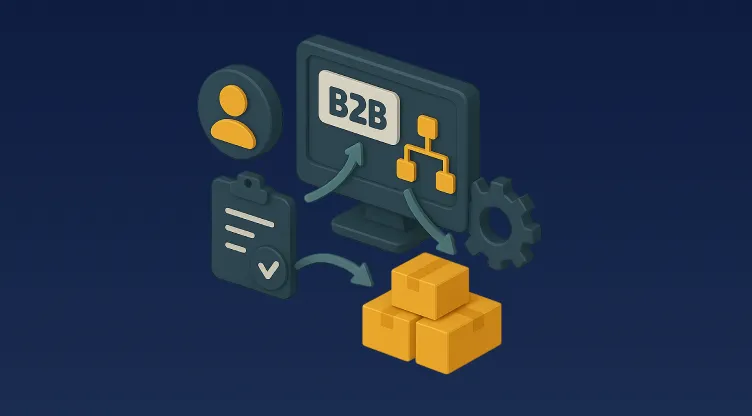The True Cost of Poor Order Accuracy and How Omniful Solves It

Table of Contents
In today's complex supply chains, even a small mistake in processing a single order can set off a costly chain reaction before the product ever reaches the customer. What might seem like a minor operational slip such as a wrong item, incorrect quantity, or delayed shipment often leads to far-reaching consequences across the business.
Each error triggers additional return shipments, re-handling costs, lost employee time, and perhaps most damaging, a decline in customer trust and satisfaction. Many businesses do not realize the true financial weight of these inefficiencies until complaints rise, margins shrink, and service quality begins to erode.
Industry research consistently shows that companies with accurate and well-synchronized fulfillment operations achieve stronger profitability and customer retention. When every system from order capture to delivery operates in sync, the result is smoother execution, higher customer satisfaction, and long-term loyalty.
Investing in accuracy is no longer an operational preference; it is a profitability strategy. A customer who receives the right order on time and without friction becomes more than a buyer; they become an advocate for your brand.
In this article, we will unpack the real financial cost of poor order accuracy, explore how small fulfillment errors compound into major losses, and show how Omniful’s Order Management System (OMS) helps businesses restore precision, control, and confidence across the entire order lifecycle from purchase to delivery.
First: What Does Poor Order Accuracy Mean?
Order accuracy means that the customer receives the right product, in the right quantity, in the right condition, at the right time.
Companies with high accuracy reduce returns, maintain customer trust, and protect their profit margins.
Companies with low accuracy pay a double price: the cost of fixing the error now, and the cost of losing the customer later.
Formula:
Order Accuracy Rate = (Number of error-free orders ÷ Total orders) × 100
Accepted benchmarks:
According to recent supply chain studies, a rate between 96% and 98% is considered good, while 99.5% and above is considered high-performance in logistics.
Example:
If you have 1,000 orders and 20 errors:
(980 ÷ 1000) × 100 = 98%
Common errors include:
- Picking the wrong product (mis-pick)
- Wrong quantity (sending 1 instead of 2, or vice versa)
- Correct product but actually out of stock (overselling)
- Wrong address or wrong warehouse for shipping
- Splitting an order into multiple shipments unnecessarily, increasing delivery costs
These aren’t isolated cases, every time an error occurs, a full chain of corrective actions is triggered (receiving complaint, creating return label, sorting the return, re-shipping the correct item, etc.), instead of focusing on fulfilling new orders.
Second: The Cost of Operational Errors: Where Does the Loss Begin?
Let’s calculate in operational language.
1. Cost of a single error
Supply chain studies estimate that a single mis-pick can cost between $30 and $75 on average, after factoring in additional shipping, return processing, employee time, and possible refunds or discounts to angry customers.
Multiplied shipping cost
Every wrong shipment usually means:
- Wrong item shipped to the customer (already paid shipping)
- Return shipment from customer back to you (your cost)
- Correct item shipped again (your cost)
That means you’ve paid for logistics three times for one order, but earned its revenue only once.
2. Opportunity cost
Warehouse staff fixing wrong orders instead of fulfilling new ones reduces your throughput capacity.
That affects Fulfillment SLA, causing delays for other customers who did nothing wrong.
3. Reputation cost
Low accuracy translates directly into lower loyalty.
Studies show that customers receiving inaccurate orders are much less likely to buy again, while a consistent, accurate experience builds long-term trust.
4. Higher return rates
Every wrong order usually ends up as a return and returns are historically more expensive than original fulfillment: inspection, quality check, restocking, or disposal.
These are pure costs that eat into your margins.
The result?
Even if your accuracy is “good” at 98%, that means 2 out of every 100 customers are unhappy and 20 out of every 1,000 orders are wrong.
If you ship tens of thousands of orders per month, that’s thousands of cases costing tens of dollars each, turning into six- or seven-figure annual losses for large companies.
Direct and Indirect Costs of Poor Order Accuracy
| Type of Loss | What Actually Happens | Tangible Financial Impact |
|---|---|---|
| Wrong shipment / wrong product | Customer receives the wrong item | Return shipping + replacement shipping ($30–75 per case) |
| Wrong quantity | Must resend the correct amount or refund the difference | Refund / discount / lost margin |
| Replacement delay | Staff fixing errors instead of fulfilling new orders | Unproductive labor cost + slower execution |
| Negative review / lost loyalty | Customer doesn’t repurchase | Lower LTV and reduced repeat rate |
| High return rate | Return handling, inspection, restocking | Return cost usually exceeds original fulfillment cost |
Bottom line:
Poor order accuracy is not a small mistake, it’s a profit leak happening every single day.
Third: Main Causes Behind These Errors
They repeat in nearly every warehouse and operations team:
1. Manual order entry
Orders from various channels (online store, marketplace, in-store POS, B2B) are manually consolidated in sheets or messages.
That opens the door to human error: similar SKUs, similar descriptions, or just typing the wrong number.
2. Unsynced inventory
Different platforms don’t “talk” in real time.
Result: the system thinks an item is available while it’s sold elsewhere, leading to overselling and delayed or partial shipments.
3. Unguided picking
Warehouse staff walking around manually searching.
Without intelligent guidance (aisle, location, priority), error rates rise.
Studies show that mis-picks occur in 1–3% of orders, enough to erode profitability.
4. No verification controls
No barcode scanning during picking or packing.
No final validation before shipping.
A small mistake easily leaves the building and reaches the customer.
5. System fragmentation
If an OMS exists, it often works alone.
Inventory is managed elsewhere.
Shipping handled by another tool.
Anything disconnected creates blind spots where mistakes hide.
And that’s exactly what Omniful OMS was designed to solve.
Fourth: How Omniful’s OMS Solves the Problem at the Root
Omniful doesn’t just “fix” mistakes after customers complain, it prevents them from happening in the first place.
1. Unified order source
Omniful OMS centralizes all orders from every sales channel "online store, marketplace, retail branches, wholesale, and partner orders" into a single dashboard.
No manual copying, no human input errors. The system pulls data directly from the source channel.
✅ Result: Fewer input errors = fewer wrong orders from the start.
2. Real-time inventory sync
Omniful updates inventory levels instantly across channels.
When a product’s stock decreases in one warehouse, it’s either blocked for sale or rerouted to another location.
That prevents the common “sorry, the item you ordered is unavailable” scenario, which often ends in cancellations or split shipments (extra transport and packing costs).
3. Intelligent order routing
Instead of shipping from random or distant warehouses, Omniful automatically routes each order to the nearest location with the correct stock and optimal delivery window.
✅ Result:
- Faster fulfillment
- Less manual intervention
- Near-zero error probability, since each warehouse only fulfills what it’s capable of handling precisely
4. Smarter picking accuracy
When the order reaches the warehouse, staff don’t search manually.
Omniful provides clear instructions: which product, from which rack, and in what sequence.
Shortest route and clustered picking reduce unnecessary walking and cut mis-picks — which, as mentioned, cost $30–75 per error.
5. Pre-shipment validation
Before the box leaves the warehouse, the system automatically checks: correct SKU? quantity? address?
This automated validation prevents wrong orders from reaching customers, avoiding costly “fix later” scenarios.
6. Direct impact on customer service
Improved accuracy doesn’t just lower internal costs, it directly boosts customer satisfaction.
Data shows order errors are among the top causes of poor customer experience and churn.
When customers receive the correct shipment the first time, trust rises and repeat purchase rates grow — increasing Lifetime Value (LTV) without extra ad spending.
Before Omniful / After Omniful
| Aspect | Before Omniful (Manual or fragmented systems) | After Omniful (Unified OMS) |
|---|---|---|
| Order entry | Manual recording across channels → human SKU/quantity errors | Automatic order import from all channels (no manual copying) |
| Inventory status | Delayed / unsynced updates | Real-time sync prevents overselling |
| Order routing | Random or manual warehouse selection | Automatic routing to best/nearest warehouse with correct stock |
| Warehouse picking | Manual search, long walks, higher mis-pick rate | Smart routes, clear instructions, prioritization by delivery time |
| Pre-shipment check | Quick manual check or none | Automated pre-ship validation ensures accuracy |
| Financial impact | $30–75 correction per error, repeated shipping, lost loyalty | Fewer errors → fewer returns → lower cost → higher satisfaction & repurchase |
| Operations team focus | Problem-solving, refund processing | Proactive control, performance optimization, scalable growth |
Sixth: How to Summarize All This in One Simple Equation
Annual error cost = (Total yearly orders × Error rate) × (Average cost per error)
Quick breakdown:
- Total yearly orders: number of orders shipped in 12 months
- Error rate: % of inaccurate orders (e.g. 2%)
- Average cost per error: replacement shipping, return, labor time, discount/refund ($30–75)
Example:
If you ship 200,000 orders per year,
Error rate = 2% (0.02)
Average cost per error = $40
→ 200,000 × 0.02 = 4,000 wrong orders
→ 4,000 × $40 = $160,000 annual direct loss
And this doesn’t include bad reviews, reputation costs, or lost customers after poor experiences.
Conclusion: What Does This Mean for Operations, Supply Chain, and CX Managers?
If you’re an operations leader, all of the above means two main things:
1. The issue isn’t “human error” — it’s process fragmentation.
Orders live in one place, inventory in another, and warehouses act independently.
That’s where Omniful OMS delivers its value: unifying channels, synchronizing inventory, and getting execution right the first time instead of firefighting later.
2. Every extra point of accuracy = real money.
Reaching near-perfect accuracy (99%+) means:
- Fewer returns
- Less wasted warehouse time
- Better customer experience
- Protected long-term margins
In a fast market, customers won’t wait for you to fix mistakes — they’ll move to a competitor.
Operations teams can’t afford to fix what could’ve been prevented from the start.
Omniful OMS is designed to solve the problem at its root:
- Unified orders
- Real-time inventory sync
- Intelligent routing
- Preventing errors before they happen
✅ The result: Higher accuracy from the first shipment. Lower cost per order. Stronger customer loyalty every time.























